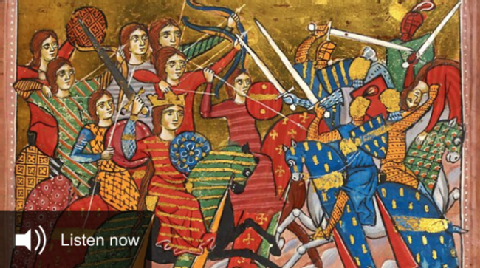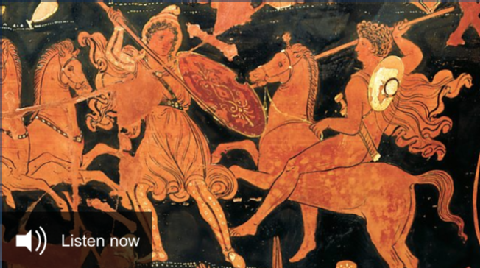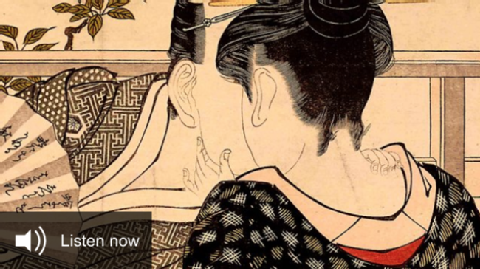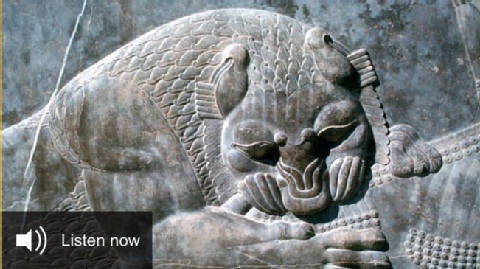Invention of the Barbarian (H408/23)
AIE resources illustrate the relevance of ancient Athenian inscriptions, especially those of the classical period (the fifth and fourth centuries BC, c. 500-300 BC), to pre-18 education in the UK and beyond. They aim to support teachers who wish to introduce inscriptions into their teaching as a way of captivating their students’ imagination and fostering enthusiasm for the ancient Greek world.
These resources, consisting of teachers’ notes and slides for classes, underline the textual and visual potential of inscriptions for those engaged with learning about ancient Greek history and civilisation. The idea of an inscription being carved and read “in real life” is a way of fostering the curiosity of students about the past. Accordingly, through inscriptions, learners benefit from the bringing to life of the ancient world, perhaps in a way that helps it seem less abstract and initially less complicated. At the same time, they hope that introducing students at pre-18 level to inscriptions will encourage them to explore ancient source material of their own accord, and will help them to ‘bridge the gap’ into University study if they chose to pursue it. In their Introduction to AIE for Teachers resource you will find more ideas about using inscriptions in the classroom. They also offer a set of slides which introduce learners of all ages to Greek inscriptions: see Introduction to ancient Athenian inscriptions.
The Persian Wars
[Source: Introduction to Ancient Greek History with Donald Kagan]
The course 'Introduction to Ancient Greek History' is a series of lectures delivered by the great Donald Kagan to undergraduates at Yale and is an excellent and comprehensive overview of Ancient Greek history from the Bronze Age to the end of the classical period. Episodes 12-20 are of especial interest to this topic.
Kings College London Video Resources
Other Videos
Medea
The Warwick Classics Society Production of Euripides' Medea 2018, performed as part of the Warwick Ancient Drama Festival.
The Amazons
[Source: BBC Radio 4 - In Our Time]
Melvyn Bragg and his guests discuss the Amazons, a tribe of formidable female warriors first described in Greek literature. They appear in the Homeric epics and were described by Herodotus, and featured prominently in the decoration of Greek vases and public buildings. In later centuries, particularly in the Renaissance, the Amazons became a popular theme of literature and art. After the discovery of the New World, the largest river in South America was named the Amazon, since the warlike tribes inhabiting the river's margins reminded Spanish pioneers of the warriors of classical myth. With Paul Cartledge, A.G. Leventis Professor of Greek Culture at Cambridge University; Chiara Franceschini, Teaching Fellow at University College London and an Academic Assistant at the Warburg Institute; and Caroline Vout, University Senior Lecturer in Classics and Fellow and Director of Studies at Christ's College, Cambridge.
The Amazons
[Source: BBC Radio 4 - Start the Week]
On Start the Week Tom Sutcliffe talks to Adrienne Mayor about the Amazons, the legendary warrior women who glorified in fighting, hunting and sexual freedom. The Greeks described these wild barbarian archers, and Mayor reveals new archaeological discoveries which prove these women were not merely figments of their imagination.
The Real Amazons
[Source: BBC World Service - Everywoman]
Legends abound about warrior queens and 'Amazons' - a new book suggests they originate from Benin, West Africa. Also on the programme: The women who dressed as men and became pirates. A play about Grenada calls for the release of a Marxist woman prisoner. This week's topical diary comes from an advisor on women's employment rights in Bolivia.
Herodotus
[Source: BBC Radio 3 - Night Waves]
(14:21-22:55) Tom Holland shares his passion for Herodotus.
Persepolis
[Source: BBC Radio 4 - In Our Time]
Melvyn Bragg and guests discuss the role of the great 'City of the Persians' founded by Darius I as the ceremonial capital of the Achaemenid Empire that stretched from the Indus Valley to Egypt and the coast of the Black Sea. It was known as the richest city under the sun and was a centre at which the Empire's subject peoples paid tribute to a succession of Achaemenid leaders, until the arrival of Alexander III of Macedon who destroyed it by fire supposedly in revenge for the burning of the Acropolis in Athens. With Lloyd Llewellyn-Jones (Professor of Ancient History at Cardiff University), Vesta Sarkhosh Curtis (Curator of Middle Eastern Coins at the British Museum), and Lindsay Allen (Lecturer in Greek and Near Eastern History at King's College London)
Persepolis Regained
[Source: BBC World Service - Masterpiece]
Persepolis existed for 14 centuries until Alexander the Great burnt it to the ground. Presenter Vesta Sarkhosh Curtis takes a trip to the ruins of the ancient capital of the Persian Empire located near Shiraz in the South of modern day Iran.
The Cyrus Cylinder
[Source: British Museum, Published on 18 Jul 2014]
The Cyrus Cylinder is one of the most famous objects to have survived from the ancient world. It was inscribed in Babylonian cuneiform on the orders of Persian King Cyrus the Great (559-530 BC) after he captured Babylon in 539 BC. The cylinder is often referred to as the first bill of human rights as it appears to encourage freedom of worship throughout the Persian Empire and to allow deported people to return to their homelands. It was found in Babylon in modern Iraq in 1879 during a British Museum excavation.







